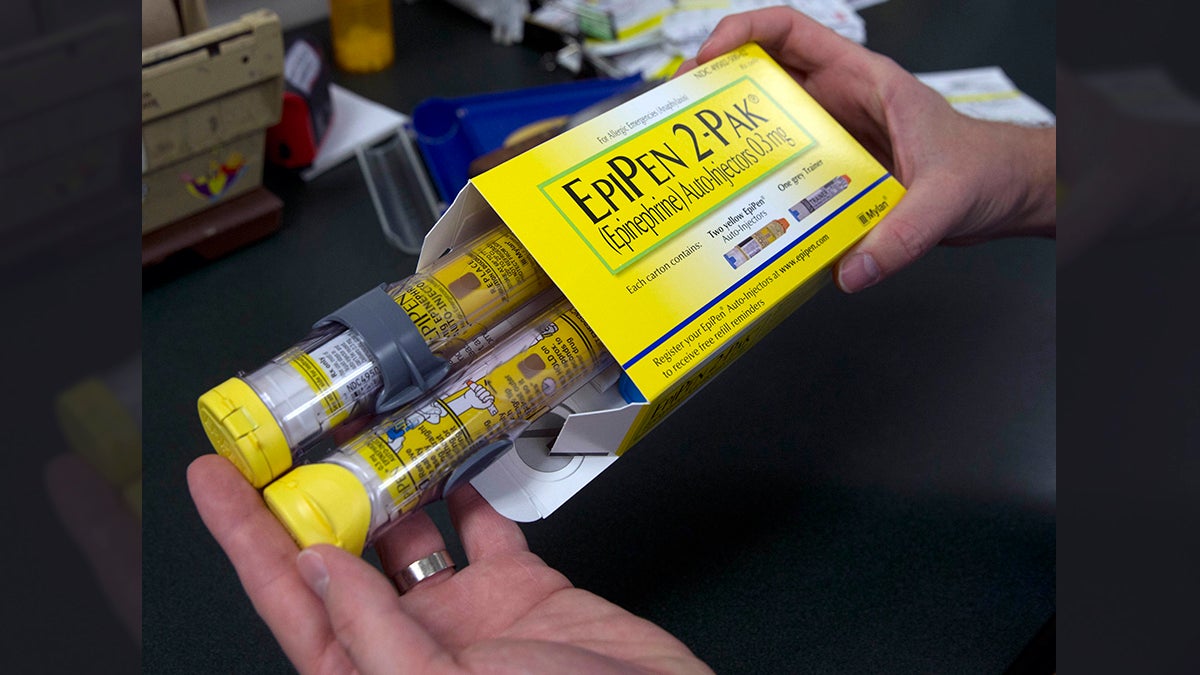Money vs. health: How those with allergies have dealt with rising price of EpiPens

A pharmacist holds a package of EpiPens epinephrine auto-injector
When Carolyn Funk, a 51-year-old hairstylist from Pittsburgh had a peanut scare last month, the allergist gave her a $100 coupon to pick up an EpiPen. The auto-injectors contain epinephrin, which can stop a life-threatening allergic reaction.
Even with the discount, it still cost Funk $500.
“I was like, well, I guess I’m going to decide if I’m going to pay my car payment or get my EpiPen this month,” she remembered thinking.
For people like Funk, who have high-deductible health plans that require paying a lot out of pocket before insurance coverage kicks in, the price of an EpiPen can be a shock. Over the last decade, the price has gone from about $90 to $600 for a two pack.
Knowing that it could save her life, Funk paid for it anyway.
Anna Bechtel, a nurse in Philadelphia, said she cannot afford not to have EpiPens on hand. Both of her children, 4 and 2, and her husband have severe allergies.
“I’ve never had to use them, although I’ve had several scares where I thought I was going to have to,” she said.
Bechtel has six EpiPens, two for each family member, which is what’s recommended. Knowing the high price of the medication, her family enrolled in a more comprehensive insurance plan through her husband’s work. The monthly premiums are higher, but, she said, in the long term, it’s cheaper — especially if it avoids a costly trip to the emergency room.
“We’re very fortunate,” she said. “For us, the EpiPen costs less than $5 an EpiPen, so our insurance covers the bulk of the cost.”
Robert Mizenko, a 49-year-old truck driver from Monaca, Pennsylvania, with a severe allergy to bees didn’t have that option. So he made a different decision when it came to purchasing an EpiPen after losing his insurance a few years ago. The devices have to be replaced each year.
“You can do it once, maybe twice, but 600 bucks, that’s a lot of money,” he said. “The average working person, after they pay rent and mortgage and the car payment and the needs for the family, you just don’t have it.”
Mizenko, who cares for a grandson, took the risk and went without an EpiPen. Though he avoided a lot of outdoor activities, he was stung while mowing his lawn one day a couple years ago.
“All I remember is getting stung, grabbing my phone, and running down toward the main street that goes past my house so someone could see me,” he said.
His throat closed up. It was a close call at the ER, Mizenko recalled. And while he may have been eligible for coupons to help pay for an EpiPen, he didn’t know about it.
Mizenko has since learned he’s eligible for Medicaid, which covers the price of EpiPens. He said the hospital wrote off the tens of thousands of dollars in that emergency room visit through its charity care program.
An estimated 50 million people are at risk for severe allergic reaction in the U.S., according to a study from the Asthma and Allergy Foundation of America. The maker of EpiPens, Mylan, has been under fire for the rising price of its lifesaving allergy medication.
The situation has prompted protests outside the company’s headquarters near Pittsburgh. The company’s CEO has said a broken health system incentivizes higher prices, but in the wake of political and social backlashes, Mylan has announced new discount programs and the rollout of a generic version that will cost about half the price of the branded EpiPen.
Critics such as the advocacy group, Public Citizen, which delivered a petition to the company Tuesday, said the moves don’t get to the root of the problem, and are calling for a full rollback of the price increases.
WHYY is your source for fact-based, in-depth journalism and information. As a nonprofit organization, we rely on financial support from readers like you. Please give today.

